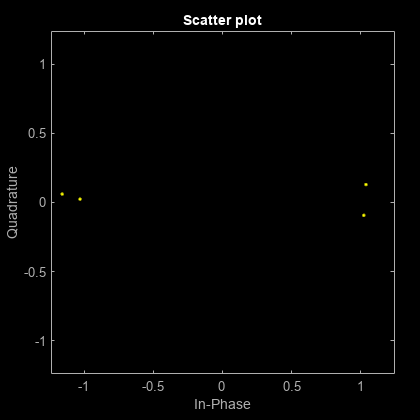lteACKDecode
HARQ-ACK channel decoding
Description
[
performs block decoding on soft input data out,blkerr] = lteACKDecode(chs,in)in, assumed to be
encoded using the procedure defined for HARQ-ACK in Section 5.2.2.6 of [1], for PUSCH channel transmission configuration
chs. The decoded output, out, is a
vector of length OACK, the number of uncoded HARQ-ACK bits
transmitted.
Note
If NBundled is 0, TDD ACK-NACK descrambling is
disabled.
Multiple codewords can be parameterized by two different forms
of the chs structure. Each codeword can be defined
by separate elements of a 1-by-2 structure array, or the codeword
parameters can be combined together in the fields of a single scalar,
or 1-by-1, structure. Any scalar field values apply to both codewords
and a scalar chs.NLayers is the total number. See UL-SCH Parameterization for
further details.
The block decoding is performed separately on each soft input
data codeword using a maximum likelihood (ML) approach, assuming that in has
been demodulated and equalized to best restore the originally transmitted
values.
The HARQ-ACK decoder performs different types of block decoding depending upon the number of
uncoded HARQ-ACK bits to be recovered (OACK). For
OACK less than 3 bits, the decoder assumes the bits are
encoded using the procedure defined in TS 36.212 [1], Section 5.2.2.6.
For decoding between 3 and 11 HARQ-ACK bits, the decoder assumes the bits are block encoded using the procedure defined in TS 36.212 [1], Section 5.2.2.6.4. For decoding between 12 and 22 bits, the decoder performs the inverse procedure described in TS 36.212 [1], Section 5.2.2.6.5. For decoding more than 22 bits, the decoder performs rate-matching, tail-biting Viterbi decoding, and 8-bits CRC decoding, which is the inverse procedure described in Section 5.2.2.6.
Examples
Input Arguments
Output Arguments
References
[1] 3GPP TS 36.212. “Evolved Universal Terrestrial Radio Access (E-UTRA); Multiplexing and channel coding.” 3rd Generation Partnership Project; Technical Specification Group Radio Access Network. URL: https://www.3gpp.org.
Version History
Introduced in R2014aSee Also
lteACKEncode | lteRIDecode | lteCQIDecode | lteULSCHDeinterleave | lteULSCHDecode | lteUCIDecode
